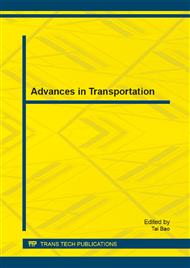p.1122
p.1127
p.1133
p.1137
p.1143
p.1148
p.1153
p.1157
p.1163
Modeling Highway Lane Changing Using Bayesian Networks
Abstract:
Developed a lane changing assistance system that advises drivers of safe gaps for making lane changes. Minimum Bayes risk decision and the minimum error Bayes decision used by the lane changes model and the decision making based on Bayesian networks is proposed. The U.S. Highway 101 vehicle trajectory data set from the Next Generation Simulation (NGSIM) were used for model training and testing. Aim to predicted driver decisions on whether to change or not. By using this method, the minimum Bayes risk decision prediction accuracy was 66.00% for non-change events and 79.92% for change events, and the minimum error Bayes decision prediction accuracy was 73.35% for non-change events and 84.10% for change events.
Info:
Periodical:
Pages:
1143-1147
Citation:
Online since:
January 2014
Authors:
Price:
Сopyright:
© 2014 Trans Tech Publications Ltd. All Rights Reserved
Share:
Citation:


